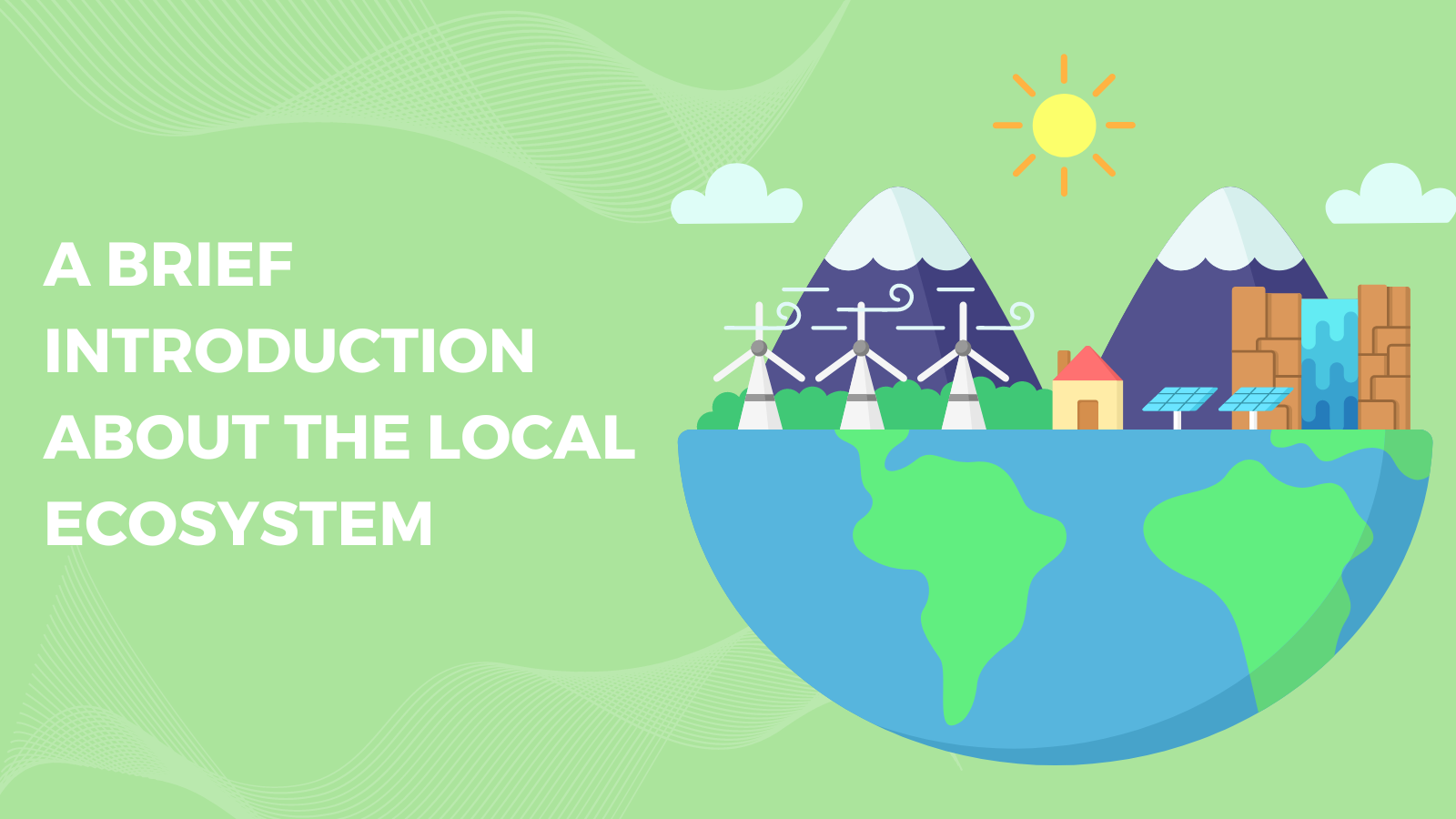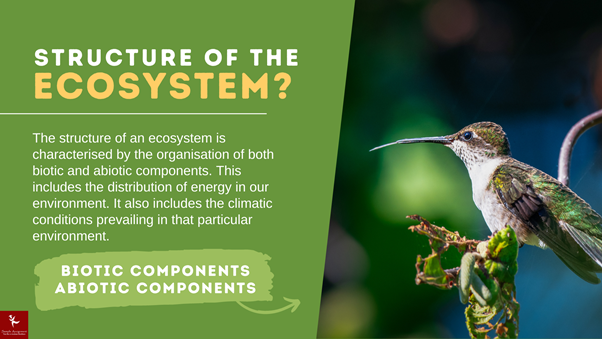
An ecosystem is a region where a life bubble is created by plants, animals, and other organisms interacting with the weather, environment, and other factors. Ecosystems are made up of both biotic (or alive) and abiotic (or non-living) components. Plants, animals, and other species are biotic factors. Along with rocks, temperature and humidity are abiotic variables.
Every component of an ecosystem is directly or indirectly dependent upon every other component. An ecosystem's temperature changes frequently impact the plants that may flourish there, for example. Animals that rely on plants for food and shelter must evolve with the times, relocate to another ecosystem, or perish. Let's examine in more detail the meaning of ecosystem and what are the factors affecting a local ecosystem.
What is a Local Ecosystem?
Ecosystems can vary greatly in size. Tide pools, or the ponds that the ocean leaves behind as the tide recedes, are full-fledged, miniature ecosystems. A type of algae called seaweed is found in tide pools and produces food through photosynthesis. Herbivores like abalone consume seaweed. Sea stars and other predatory creatures in tide pools consume clams and mussels. Tide pools are reliant on the fluctuating ocean water level. In an aquatic setting, some creatures, like seaweed, thrive when the tide is in and the pool is full. Hermit crabs, for example, cannot survive underwater and depend on the shallow pools that low tides leave behind. The biotic components of the ecosystem are thus dependent on abiotic elements.
Earth's surface is made up of a network of interconnected ecosystems. In a bigger biome, ecosystems are frequently interconnected. Large areas of land, water, or atmosphere are known as biomes. For instance, biomes include forests, ponds, reefs, and tundra. They are arranged fairly broadly according to the kinds of animals and plants that inhabit them. You will find a variety of habitats in every forest, pond, reef, and area of tundra. If you want to know more about it, you can connect with our Assignment Help Australia.

What are the Factors Affecting the Ecosystem?
Many biotic and abiotic variables can impact an ecosystem. Ecosystem disruptions can be advantageous since they accelerate the succession process. However, persistent perturbations might affect an ecosystem's capacity for regrowth and crucial functions.
Agriculture
Ecosystems are impacted by modern agriculture in several ways. When soil is ploughed, it is significantly disturbed, favouring annual crops growing quickly. In addition, it encourages the development of weeds and other pioneer species. These species mark the beginning of the ecosystem's successional evolution. Repeated ploughing, however, prevents the system from reaching its climax state. Additionally, the soil structure is harmed, and the protective covering of plant matter is removed.
Urban Planning
Healthy, productive ecosystems are destroyed by urban growth, leaving behind vast expanses devoid of biological activity. This can include parks, lawns, gardens, roads, buildings, and pavement, where several native plants are eliminated to make room for a select few alien species.
Additionally, the habitat is fragmented by urban development, which disrupts populations, modifies the habitat due to the "edge effect," and makes it more difficult for species to adapt to environmental changes.
Changing Climate
Every ecosystem is capable of adapting to changing environmental conditions. However, an ecosystem is less resilient after being impacted by human activity. A species' fragmented habitat prevents them from migrating to more suitable climates. Droughts can be more damaging when there are more fires because of human activity. As a result of repeated exposure to the elements and other soil-disturbing activity, agricultural regions are more vulnerable to erosion.
Various Species
All around the world, non-native plants and animals have been introduced by humans into new environments. Many imported species expand rapidly in size and spread due to the absence of natural predators, which profoundly affects local biodiversity. For further information, you can connect with our experts, who can also assist you with the data on factors influencing the local ecosystem.
How to Protect the Ecosystem?
Any geographic area where biotic factors (living things like animals, plants, fungus, and bacteria) and abiotic elements (such as soil, air, water, and temperature) interact is an ecosystem. And you are well versed with that definition. Now, you should be aware of how you can protect your ecosystem.
Conserving the Ecosystem
Where one ecosystem begins and ends is not clearly defined. Oceanic kelp forests, coral reefs, mangroves, the Amazon rainforest, and the Arctic tundra are well-known examples of ecosystems. To conserve the ecosystem, you can consider how you interact with the environment.
Saving water
By turning off the water while brushing your teeth, repairing leaking faucets, taking shorter showers, and watering plants with the cooled water from boiling veggies rather than pouring it down the drain, you can conserve water daily.
Reduce Energy Use
You will need to use energy unless you intend to live fully off the grid. Turning off lights and appliances while not in use builds up over time.
Make Sensible Food Decisions
Purchase seasonal, local, and organic food whenever you can. Farmers' markets are excellent locations to buy regional goods. You might even have a food garden of your own.
Commence composting
Organic waste can be composted to produce healthier soil for your garden and less landfill waste. Many simple composting methods, such as bokashi bins, worm farms, and compost tumblers, can be used at home.
Examine green products
Choose goods that don't include any dangerous chemicals during production or usage.
Environmentally Friendly Packaging
Packaging has a significant role in a product's environmental friendliness. Compostable and biodegradable packaging is growing in acceptance nowadays.
Reduce Waste by Recycling
Recycling either restores an item to its original usage or disassembles it into its constituent parts for reuse. Although single-use packaging that will wind up in a landfill is a far better option, the efficacy of recycling depends on the availability of local facilities.
Making New Products from Upcycled Materials
When something gets upcycled, it is repurposed to have a higher value than before. If you no longer need any jars for the kitchen, you can give them a new use by decorating them and creating adorable vases or plant holders.
Redesign Your Clothes
Purchase clothing from transparent, slow-fashion brands that emphasise eco-friendly production methods like employing organic fibres or polyester made from recycled plastic bottles and purposefully reducing fabric waste.
Give Time to a Cause
Thousands of global volunteer organisations fight to protect regional ecosystems in their spare time. Participating in trash clean-up events or native planting initiatives can assist rebuild and restoring natural habitats to sustain functioning ecosystems. Moreover, if you are looking for someone who will do my assignment? Then, you are at the right place.
So, if you are one of those who are tired of the challenges you face while working on your environmental science assignment? Then, our experts can help you. They can provide you best help in drafting your assignments.
Order Now @ Upto 50% Off
Get
Flat 50% Off
on your Assignment Now!














Loved reading this Blog? Share your valuable thoughts in the comment section.
Add comment